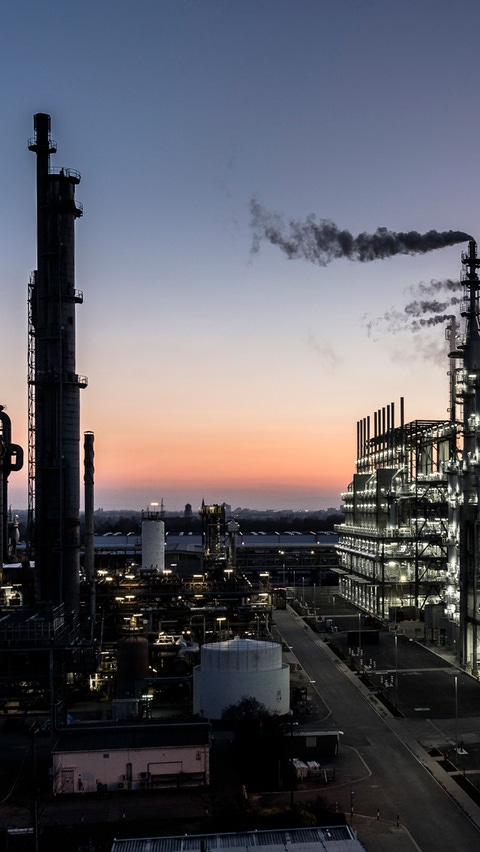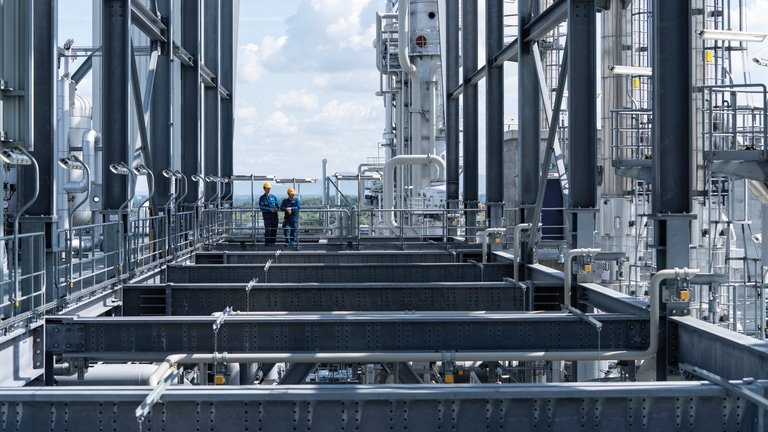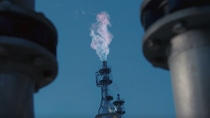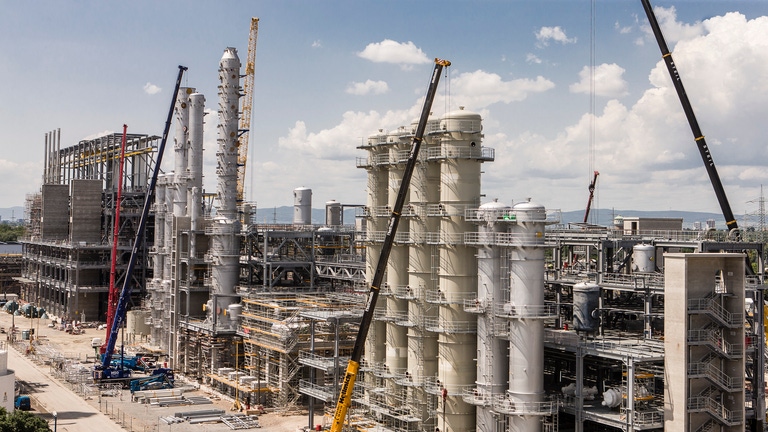The most efficient acetylene plant in the world

Ludwigshafen
The most efficient acetylene plant in the world
Two hydrogen and two carbon atoms: This is acetylene. The colorless gas is made from natural gas and oxygen. Around 20 plants in BASF's Production Verbund process acetylene and its derivatives.
As a versatile chemical building block, acetylene is an important starting material for many everyday products. Examples are plastics, pharmaceuticals, solvents, electrochemicals and highly elastic textile fibers. BASF customers use these products in the automotive, pharma, construction, consumer goods and textiles industries.
The new acetylene plant consumes about 10 percent fewer fossil raw materials per ton of end product than its predecessor.
A construction site with extraordinary dimensions
A total of 440 customized fractionating columns, machines and technical equipment from twelve countries were assembled and installed. The heart of the plant is a gas separation unit 60 meters long and weighing 225 tons which was transported by ship from China to Ludwigshafen.
The new acetylene plant at the Ludwigshafen Verbund site replaces the previous plant, which went into operation in 1964. It is equipped with state-of-the-art technology and thus enables highly efficient acetylene production. Being the backbone of various value chains, the new world-scale plant contributes to a long-term improvement of the site's competitiveness. To perform at the highest level, top performance was also required during the construction phase. BASF's own expert teams as well as many highly specialized external companies were involved. A selection.
Would you start with the staircases on a construction site? When building the new acetylene plant, there was no other way. Since the staircases are up to 50 meters high, material had to be transported to the top by crane. Parts falling from this height could have seriously damaged the plant if it had already been standing. A job for real professionals: the construction companies responsible, Züblin and Heberger, hired specialist companies from Bavaria and Austria to build the staircases. A total of eleven staircases rose freestanding into the sky before work on the actual plant began. They looked like the first lighthouses of the new factory.
The best plant is useless as long as there are no roads and paths leading to it. An assignment for Faber Bau GmbH, who built 31,000 square meters of asphalt, gravel and paved surfaces. The challenge was to realize the chessboard-like construction plan without disturbing the ongoing work on the plant – with at times 1,500 people on the site or the surrounding production facilities. BASF's construction site management helped here by setting up the appropriate traffic barriers and detours. In the end, the close coordination between Faber and BASF across various disciplines led to success.
For the assembly of machines, technical equipment and pipelines in the acetylene plant, only absolute experts in their field were considered. However, all European providers of these services were fully booked. BASF therefore teamed up with the Turkish company Gemont, which was operating in Europe for the first time and already had a great deal of experience with petrochemical projects. The special feature of Gemont: All employees who work for Gemont on construction sites belong directly to the company and are not hired externally, enabling good interaction between the project managers and their teams. Gemont sent up to 500 workers from Turkey to Ludwigshafen for the acetylene plant. Another success factor during the construction work was that Gemont was able to provide important tools such as cranes from its own pool, which were permanently available on the construction site and helped speeding up many of the tasks.
During the construction of large plants such as the new acetylene plant, the scaffolding reaches an enormous height. In addition, it often has to be rebuilt because space is quickly becoming scarce during the assembly of pipelines, cable trays or technical equipment. It therefore helps if you can plan the scaffolding as easily as possible in advance: with a 3D model by the company promaintain, 80 percent of all scaffolding was created via computer before it was actually erected – each clearly marked with a QR code. The 3D model was planned using innovative scaffolding material with metric dimensions from Peri, who also supplied the actual scaffolding. For later maintenance work or shutdowns, the scaffold planning no longer starts from zero, but is based on the already existing model – a great advantage.
Photo: Promaintain
Do you know what "high plant availability" means? Very simple: As few disturbances and incidents interrupting production as possible. A state-of-the-art automated safety system makes a decisive contribution to this. HIMA Paul Hildebrandt GmbH fulfilled this job by supplying a complete package of hardware, software and engineering for the new acetylene plant: 61 control room racks enabling field devices to be read out were pre-assembled and tested in-house. Two HIMA engineers were permanently on site in Ludwigshafen from October 2018 to ensure the seamless integration of the system. The devices communicate with each other, allowing the system to start up and control the plant safely in a smart way, as well as ensuring fast safety shutdowns if necessary. A particularly advanced feature is that software upgrades can be carried out while the system is in operation. This means that the safety system not only protects employees and the plant from serious impacts in case of incidents, but also makes the plant future-proof for all potentially upcoming developments in Industry 4.0.
Photo: HIMA Group
More information about the HIMA safety technology in the acetylene plant
With a length of up to ten meters and a weight of 4.5 tons, the pipes of the new acetylene plant have extraordinary dimensions - even by BASF standards. BASF's own workshop for piping engineering constructed a total of 240 meters of piping within twelve months. A special challenge: keeping the inner pipes free of oil and grease so that no unwanted reactions occur in the plant. In order to meet the highest quality requirements, the workshop kept a so-called pipe book in which every single weld seam was recorded and can be matched to the respective welder. The responsibility for transporting the heavy components from the workshop to the construction site lay with the colleagues from BASF's heavy equipment installation department. The entire production process was accompanied by TÜV-Süd, which was also responsible for the approval of the pipelines. The basic prerequisite for success: perfect cooperation within the unit and between the individual trades.
Cracked gas compressors weighing several tons are among the most important components in the acetylene plant. The Japanese manufacturer delivered them to Ludwigshafen on time, but during assembly it turned out that some of them had rusted during delivery. Now, there were two alternatives: Either send the units back to Japan to have them repaired by the manufacturer or repair them on site. In order not to disrupt the complex schedule of the acetylene plant, the colleagues decided for the latter. Repair works were conducted successfully by a team of experienced BASF craftsmen, “BASF-Meistern”, technicians and engineers in close cooperation with the supplier. Significant contributions were also made by BASF's expert teams for materials engineering and machining technology. The key to success: close networking of the specialist departments at BASF and open communication with the manufacturer, who disclosed all relevant construction documents.
During the assembly it turned out that some of the pipeline parts did not fit. The reason: Due to the temperatures during welding, their flanges were warped, making a tension-free assembly impossible. Thanks to intensive cooperation between BASF's materials engineering unit, which immediately calculated the minimum permissible flange blade thickness, and the BASF machining technology team, the flanges were successfully re-engineered. A total of 32 pipeline parts had to be reworked. In addition, a reworking of a compressor housing was necessary. During a 3D scan, unevennesses of 0.2 mm were found on critical surfaces. Thanks to its own pool of machine tools, the machining technology unit was able to quickly solve the problem.
Acetylene coke is an unavoidable by-product during acetylene production. To prevent it from clogging the combustion chamber, it must be permanently removed - a never-ending task that was done manually until 1992. Since then, a poking robot takes care of this task, every 12 minutes, 24 hours a day, 365 days a year. The robot only has 17 seconds to complete the job, otherwise the poking rod would burn in the combustion chamber. Each of the ten acetylene burners in the new plant has its own poking robot, which were developed by BASF's own Innovative and Prototype Solutions team.
The maintenance team of the old acetylene plant has extensive know-how from decades of operation. Therefore, it was involved in the project planning of the new plant from the very beginning. From planning to commissioning, knowledge in process engineering and process control technology played a major role. Equally important was the expertise in new areas such as digitalization and 3D modeling. That's why colleagues from the relevant units quickly came on board, e.g. during acceptance tests with external manufacturers – one example is the process control technology from Siemens. Digitalization has long since become part of everyday work in the new acetylene plant, for example in the form of tablets that can be used to operate various parts of the plant from outside of the control room.
To operate chemical plants safely in the long term, they have to be continuously checked for their full functionality. This is why non-destructive testing is important, which can be compared to a preventive medical check-up. Technical equipment, reactors, heat exchangers and pipe bundles must also undergo such an examination on a regular basis. BASF has big expertise in non-destructive testing and has even co-developed some of the test procedures itself. In addition to the procedures familiar from medical practice, such as ultrasound, X-ray, endoscopy or videoscopy, infrared thermography is used, for example to inspect pipelines, or eddy current testing on heat exchanger tubes. Thanks to special procedures, people don't have to enter tanks and containers as often as in earlier times. For important components, BASF's team for non-destructive testing also goes beyond the legally required level. One example for this are measurements of the zero state on heat exchangers: Here, the natural gas and oxygen heaters of the acetylene plant were put under special scrutiny. During future shutdowns, the measurements will be repeated and compared with the zero state measurement data from the time of their production. This way, changes in materials can be quickly identified. The results can be used to determine the need for future inspections. BASF's own materials technology unit is involved intensively in inspection planning. In this team, experts for corrosion, strength calculations and damage assessments can be found.
Sikla GmbH, a specialist for modular steelwork solutions, supplied 8,750 modular support structures and more than 9,100 pipe bearings for the new acetylene plant. In a trusting and cooperative partnership, time and cost savings were successfully implemented while at the same time meeting high safety requirements.
All about acetylen
From history to benefits and sustainability.


.jpg)
.jpg)